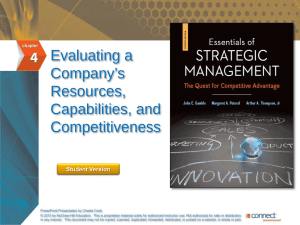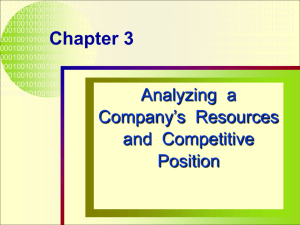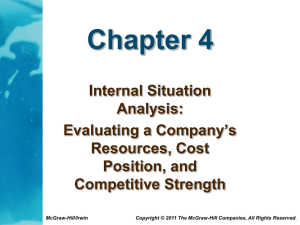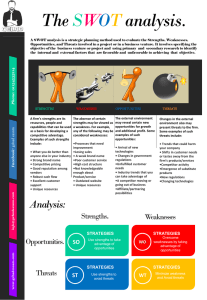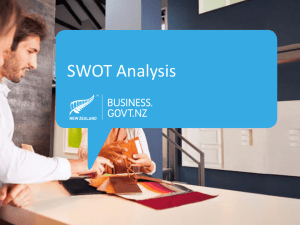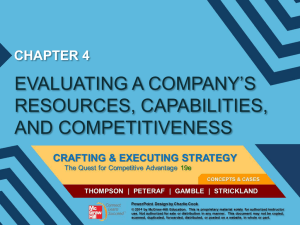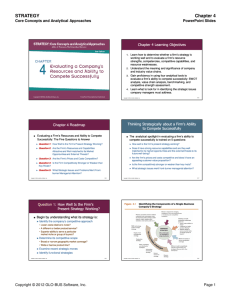Chapter 4 part 2
advertisement
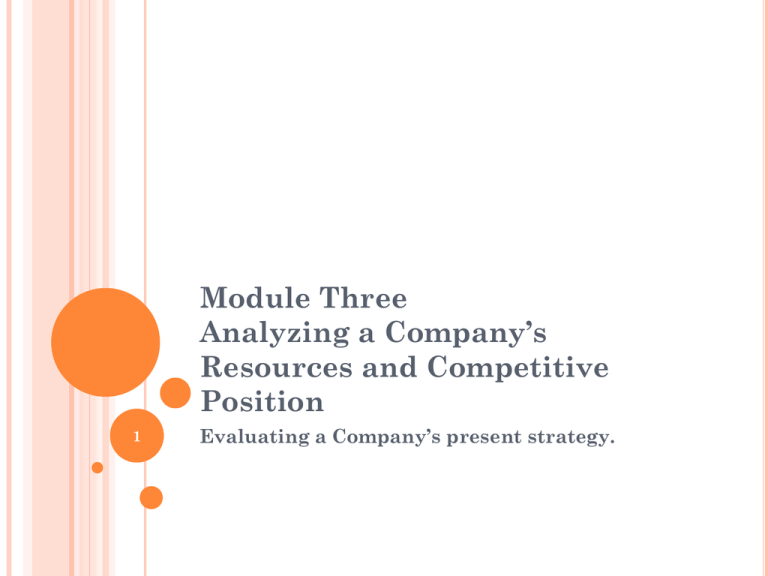
Module Three Analyzing a Company’s Resources and Competitive Position 1 Evaluating a Company’s present strategy. Evaluating How well a company’s present strategy is working Company’s competitive approach. The 4 general strategies. Firm’s competitive scope within the industry. What is its geographical market. Whether it operates in just a single stage of the industry OR is vertically integrated across several stages. Company’s recently moves to improve competitive position and performance. its E.g. cutting prices, entering new geographic market, merging with a competitor. 2 Evaluating How well a company’s present strategy is working Evaluating a company’s strategy Qualitative standpoint Quantitative standpoint E.g. its completeness, relevance, internal consistency Evidence of how well the company’s strategy is working comes from its results. Two BEST empirical indicators: Whether the company is achieving its stated financial and strategic objectives Whether the company is an above-average industry performer. 3 Evaluating How well a company’s present strategy is working Persistent shortfalls in meeting company performance targets and weak performance Poor strategic making Less than competent strategy execution. The Stronger a company’s current overall performance, the less likely the need for radical changes in strategy. The weaker a company’s financial performance and market standing, the more its current strategy must be questioned. Weak performance is almost always a sign of weak strategy, weak execution or both. 4 SWOT analysis Strength and Weaknesses and its external Opportunities and Threats. A simple but powerful tool. Provides the basis for crafting a strategy that capitalizes on the company’s resources, aims squarely at capturing the company’s best opportunities and defends against the threats to its well-being. 5 Identifying Company Resource Strengths & Competitive Capabilities. Strength – something a company is good at doing or an attribute that enhances its competitiveness. A strength can take any of several forms: Competitive assets. Please refer to the readings A company’s resources strength represent competitive assets. A company’s competencies can range from merely a competence in performing as activity to a core competence to a distinctive competence: Competence Core competence Distinctive competence 6 Identifying Company Resource Strengths & Competitive Capabilities. Some competencies and capabilities merely enable market survival – most rivals have them. Not having a competence and capability that rivals have can result in competitive disadvantage. Core competencies are competitively more important than competencies – they add power to the company’s strategy and have bigger impact on its position and profitability. An activity that a company perform well enough. Distinctive competence – occasionally, a company may have a uniquely strong competitive capability that holds the potential for creating competitive advantage and deliver values to the buyers. The activity that allowed the company to enjoy superiority. 7 Identifying Company Resource Strengths & Competitive Capabilities. The Importance of a distinctive competence to strategy making: The competitively valuable capability it gives a company. Its potential of being a cornerstone of strategy The competitive edge it can produce in the marketplace. Easier to built competitive advantage when a firm has a distinctive competence in performing an activity important to the market success. When rival companies do not have offsetting competencies. When it is costly and time-consuming for rivals to imitate the competence. 8 What is the competitive power of a resource strength? The competitive power of a company strength is measured by how many of the following four tests it can pass. Is the resource strength hard to copy? Is the resource strength durable – does it have staying power? Is the resource really competitively superior? Can the resource strength be trumped by the different resource strengths and competitive capabilities of rivals? 9 Identifying company resource weaknesses and competitive deficiencies A weakness, or competitive deficiency something a company lacks or does poorly – when compare to others. A condition that puts it at a disadvantage in the marketplace. A company weaknesses relate to: Inferior or unproven skills, expertise or intellectual capital in competitively important areas of the business. Deficiencies in competitively important physical, organization or intangible assets. Missing or competitively inferior capabilities in key areas. 10 Identifying company resource weaknesses and competitive deficiencies Competitive liabilities Internal weaknesses, shortcomings in a company’s complement resources. Nearly all companies have competitive liabilities. Whether a company’s resource weaknesses make it competitively vulnerable depends on how much they matter in a marketplace and whether they are offset by other company’s strengths. The ideal condition is for company’s competitive assets to outweigh its competitive liabilities. 50-50 balance is definitely not the desired condition. 11 Identifying a company’s market opportunities. Market opportunity is a big factor in shaping the company’s strategy. Managers cannot properly tailor strategy to the company’s situation without first identifying its opportunities and appraising the growth and profit potential each one holds. Company’s opportunities can be plentiful or scarce and can range from (ranking) Wildly attractive (“MUST” pursue) Marginally interesting – the growth and profit potential are questionable Unsuitable – because there is not a good match with the company’s strength and capabilities. 12 Identifying a company’s market opportunities. Managers have to guard viewing every industry opportunity as a company opportunity, because Not every company is equipped with the resources to successfully pursue each opportunity that exist in its industry. Some companies are more capable of going after a particular opportunities than others. Deliberately adapting a company’s resource base to put it in position to contend for attractive growth opportunities is something strategists must pay keen attention to . 13 Identifying a company’s market opportunities. The market opportunities most relevant to a company are those that match up well with the company’s financial and organizational resource capabilities, offer the best growth and profitability, and present the most potential for competitive advantage. Dr. Masayuki Kondo Company rarely innovates alone in this age of business without corporate boundaries. Select some strategic technological fields and concentrate its technological efforts in those to compete in the global competitive market. Invest in various fields and options, because a new technology to replace current technologies of that company may appear from different technological fields. 14 Identifying the Threats to a Company’s future profitability. Certain factors in a company’s external environment pose threats to its profitability and competitive well-being. Threats Emergence of cheaper or better technologies. Rivals’ introduction of new or improved products. The entry of lower-cost foreign competitors into a company’s market stronghold. New regulations that are more burdensome to a company than to its competitors Vulnerability to a rise in interest rates The potential of a hostile takeover. Unfavorable demographic shifts Adverse changes in foreign exchange rates. Political upheaval in a foreign country where the company has facilities. 15 Identifying the Threats to a Company’s future profitability. It is management’s job to identify the threats to the company’s future well-being and to evaluate what strategic actions can taken to neutralize or lessen their impact. 16 SWOT – Identify, Draw Conclusions, Strategic action. Identify company resource strengths and competitive capabilities Identify company resource weaknesses and competitive deficiencies Identify company’s market opportunities Identify external threats to the company’s future well-being Conclusions concerning the company’s overall business situation: • Where on the scale from “alarmingly weak” to “exceptionally strong” does the attractiveness of the company’s situation rank? • What are the attractive and unattractive aspects of the company’s situation? Actions for improving company strategy: • Use company strengths and capabilities as cornerstones for strategy. • Pursue those market opportunities best suited to company strengths and capabilities. • Correct weakness and deficiencies that impair pursuit of important market opportunities or heighten vulnerability to external threats. • Use company strengths to lessen the impact of important external threats. 17 SWOT – Identify, Draw Conclusions, Translate into Strategic Action. A company’s resource strength generally form the cornerstones of strategy because they represent the company’s best chance for market success. Strategies that place heavy demands on areas where the company is weakest or has unproven ability are suspect and should be avoided. If a company doesn’t have the resources and competitive capabilities around which to craft an attractive strategy, managers need to Upgrade existing organizational resources and capabilities and add others as needed OR To acquire them through partnerships OR Strategic alliances with firms possessing the needed expertise. 18 SWOT – Identify, Draw Conclusions, Translate into Strategic Action Managers have to look toward correcting competitive weaknesses that make the company vulnerable, hold down profitability or disqualify it from pursuing an attractive opportunity. Sound strategy making requires shifting through the available market opportunities and aiming strategy at capturing those that are most attractive and suited the company’s circumstances. Rarely does a company have the resource depth to pursue all available market opportunities simultaneously without spreading itself too thin. 19 Company’s prices and costs – competitive One of the most telling signs of whether a company’s business position is strong or precarious is whether its prices and costs are competitive with industry rivals. Price competition are especially critical in a commodity-product industry where the value provided buyers is the same from seller to seller – price competition is typically the ruling market force, and lower-cost companies have the upper hand. 20 Company’s prices and costs – competitive Rival companies have to keep their costs in line and make sure that any added costs they incur and any price premiums they charge, create ample buyer value. For a company to compete successfully, its costs must be in line with those of close rivals. While some cost of disparity is justified so long as the products or services of closely competing companies are sufficiently differentiated. A high cost firm’s market position becomes increasingly vulnerable the more its costs exceed those of close rivals. 21 Company’s prices and costs – competitive The value chain includes a profit margin because a markup over the cost of performing the firm’s valuecreating activities is customarily part of the price (total cost) borne by the buyers. A fundamental objective of every enterprise is to create and deliver a value to buyers whose margin over cost yields an attractive profit. Disaggregating a company’s operations into primary and support activities expose the major elements of the company’s cost structure. Each activity in the value chain give rise to costs and ties up assets; assigning the company’s operating costs and assets to each individual activity in the chain cost estimates and capital requirement. 22 Company’s prices and costs – competitive There are links between activities such that the manner in which one activity is done can affect the costs of performing other activities. The combined costs of all various activities in a company’s value chain define the company’s internal cost structure. The costs of each activity contributes to whether the company’s overall cost position relative to rivals is favorable or unfavorable. The task of value chain analysis and benchmarking are to develop the data for comparing a company’s costs activity by activity against the costs of key rivals and to learn which internal activities are a source of cost advantages and disadvantages. A company’s relative cost position is a function of how the overall costs of the activities it performs in conducting business compare to the overall costs of the activities formed by rivals. 23 Company’s prices and costs – competitive A company’s value chain is embedded in a larger system of activities that includes the value chains of its suppliers and its distribution channel allies engaged in getting its product or service to end users. Accurately assessing a company’s competitiveness in end-use markets requires that company managers understand the entire value chain system for delivering a product or service to end users, not just the company’s own value chain. 24 Company’s prices and costs – competitive Knowing the supplier value chains are relevant because suppliers perform activities and incur costs in creating and delivering the purchased inputs used in a company’s value chain. The costs, performance features, and quality of these inputs influence a company’s own costs and product differentiation capabilities. Anything a company can do to help its suppliers’ take costs out of their value chain activities or improve the quality and performance of the items being supplied can enhance its own competitiveness – a powerful reason for working collaboratively with suppliers in managing the supply chain activities. 25 Company’s prices and costs – competitive Forward channel and customer value chains are relevant because The costs and margins of company’s distribution allies are part of the price the end user pays. The activities that distribution allies perform affect the end user’s satisfaction. For these reason, companies normally work closely with their forward channel allies (direct customer) to perform value chain activities in mutually beneficial ways. 26
